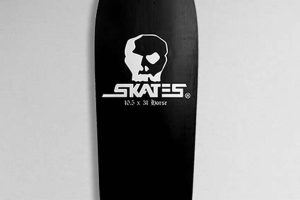These items are protective gear designed to mitigate injuries to the distal portion of the upper limb during activities involving wheeled footwear. These devices typically consist of rigid or semi-rigid splints or supports integrated with padding and straps to secure the wrist and forearm. They are engineered to absorb and distribute impact forces that commonly occur during falls.
The employment of such safety measures offers significant advantages in reducing the incidence and severity of fractures, sprains, and abrasions. Their utilization is particularly crucial for beginners and individuals attempting advanced maneuvers. Historically, the evolution of these safeguards has progressed from rudimentary padding to sophisticated designs incorporating advanced materials for enhanced impact absorption and ergonomic fit.
The subsequent sections will delve into the specific types available, factors to consider when selecting appropriate equipment, proper fitting techniques, and maintenance best practices.
Guidance on Utilizing Protective Gear for Wrist Safety
The following recommendations aim to provide individuals with practical information to optimize the effectiveness of protective measures against wrist injuries during wheeled sports activities.
Tip 1: Prioritize Proper Fit: Ensure the chosen apparatus conforms snugly to the wrist and forearm without restricting circulation or range of motion. An ill-fitting device may not provide adequate protection and can potentially exacerbate injuries.
Tip 2: Inspect Before Each Use: Conduct a thorough examination of the device prior to engaging in activity. Verify that straps, closures, and protective components are secure and free from damage that could compromise functionality.
Tip 3: Select Appropriate Padding: Opt for models incorporating high-density foam or gel padding to effectively absorb and distribute impact forces. Thicker padding generally offers increased protection.
Tip 4: Consider Splint Design: Devices incorporating dorsal and palmar splints provide enhanced support and stability. These designs can help prevent hyperextension and hyperflexion injuries.
Tip 5: Adhere to Recommended Use Guidelines: Consult the manufacturer’s instructions regarding appropriate usage and limitations. Avoid exceeding the device’s intended scope of protection.
Tip 6: Replace Worn or Damaged Equipment: Degradation of materials or structural integrity reduces protective capabilities. Replace the device immediately if signs of wear or damage are evident.
Tip 7: Practice Safe Falling Techniques: While protective equipment mitigates injury risk, mastering proper falling techniques further minimizes the likelihood of severe wrist trauma. Learn to distribute impact across the body.
Adherence to these guidelines can substantially reduce the risk of wrist injuries. However, it is imperative to remember that no protective gear offers absolute immunity from injury.
The subsequent section will explore advanced protective technologies and materials employed in current safety equipment.
1. Impact Absorption
Impact absorption is a critical determinant of the protective efficacy of wrist safety devices. Its primary function is to dissipate kinetic energy generated during a fall, thereby minimizing the force transmitted to the wrist joint and reducing the likelihood of injury.
- Material Density and Composition
The density and composition of the padding materials directly influence impact absorption. High-density foams, such as ethylene-vinyl acetate (EVA) or polyurethane, exhibit superior energy dissipation properties compared to lower-density alternatives. The inclusion of gel inserts can further enhance impact absorption due to their ability to deform and distribute force effectively. For example, protectors used by professional skaters often feature multi-layered construction incorporating both foam and gel components to provide optimal protection.
- Surface Area of Coverage
The surface area covered by the protector influences the distribution of impact forces. A larger coverage area reduces the concentration of force on specific points of the wrist. Designs that extend protection beyond the immediate wrist joint, incorporating the palm and forearm, contribute to a more even distribution of impact forces during falls. This is exemplified in protectors that feature extended splints and padded sections covering the volar and dorsal aspects of the wrist and hand.
- Splint Rigidity and Design
The rigidity and design of the splint influence how impact forces are managed. Rigid splints, typically constructed from materials such as high-density polyethylene or polypropylene, provide structural support and prevent hyperextension or hyperflexion of the wrist. However, overly rigid splints can transmit impact forces directly to the wrist joint. Therefore, the splint design must balance rigidity with impact absorption capabilities. Some designs incorporate articulated splints that allow for a degree of movement while still providing support and protection.
- Testing Standards and Certifications
Compliance with recognized testing standards and certifications indicates that the product has undergone rigorous evaluation to ensure its impact absorption capabilities meet specified requirements. Standards such as those established by ASTM International provide standardized testing methodologies for assessing the impact attenuation properties of protective equipment. Protectors bearing certifications from reputable organizations offer greater assurance of their ability to effectively mitigate impact forces.
In summary, the efficacy of impact absorption is contingent upon a combination of material properties, design features, and adherence to established testing standards. These elements contribute to the overall ability of wrist protection to minimize the severity of wrist injuries during activities involving elevated risk of falls.
2. Secure Fit
A secure fit is a foundational element in the functionality of wrist safety equipment. It ensures the device remains correctly positioned during use, maximizing its protective capabilities and minimizing the risk of displacement upon impact.
- Adjustable Straps and Closures
Adjustable straps and closures are essential for achieving a customized and secure fit. These components, typically employing hook-and-loop fasteners or buckles, allow for precise adjustments to accommodate varying wrist circumferences. A secure closure prevents the protector from shifting during activity, maintaining consistent coverage of the wrist. Insufficiently tightened straps render the protector ineffective, as it may fail to absorb impact forces appropriately.
- Snugness and Circulation
A properly fitted device balances snugness with unimpeded circulation. While the protector must fit snugly to remain in place, excessive tightness can restrict blood flow, leading to discomfort or potential nerve compression. The individual should be able to comfortably move the wrist without experiencing undue pressure or restriction. Periodic adjustment of straps may be necessary to maintain optimal fit and circulation during extended periods of use.
- Anatomical Design and Contouring
Protectors incorporating an anatomical design conform to the natural contours of the wrist and forearm, enhancing both comfort and stability. Contoured padding and strategically placed flex points accommodate wrist movement without compromising protection. A well-designed protector minimizes bulkiness and maximizes range of motion, allowing for a natural feel during use. Universally designed protectors lacking anatomical contouring may not provide adequate fit for all wrist shapes.
- Sizing Accuracy and Guidelines
Adherence to manufacturer-provided sizing guidelines is crucial for selecting an appropriately sized protector. Accurate measurements of wrist circumference should be obtained prior to purchase. Using a protector that is too large or too small compromises its effectiveness. Protectors that are too large may shift during use, while those that are too small may restrict circulation or fail to provide adequate coverage. Referencing sizing charts and seeking professional fitting assistance can improve the likelihood of selecting a properly sized protector.
The interplay of adjustable straps, attention to snugness and circulation, anatomical design, and accurate sizing collectively contributes to a secure fit, a prerequisite for realizing the full protective potential of this protective equipment. A secure fit ensures the device functions as intended, minimizing the risk of wrist injuries during activities.
3. Wrist Support
Wrist support is a primary function of dedicated safety gear, integral to mitigating injury during activities involving potential falls or impacts. The design and materials employed directly influence the level of stabilization and protection afforded to the wrist joint.
- Splint Design and Material
The splint component, often constructed from rigid or semi-rigid materials like high-density polyethylene, provides structural reinforcement to the wrist. Its primary role is to restrict excessive flexion, extension, and lateral movement, preventing hyperextension or hyperflexion injuries. The contours of the splint should conform to the anatomical shape of the wrist and forearm for optimal support and comfort. The effectiveness of the splint is predicated on its ability to resist deformation under impact, effectively distributing forces away from the joint.
- Stabilizing Straps and Closures
Straps and closures work in conjunction with the splint to maintain the device’s position and enhance wrist stabilization. Adjustable straps, typically utilizing hook-and-loop fasteners, allow for a customized fit, ensuring the wrist is securely held in place. The configuration of the straps, including their placement and number, contributes to the overall stability of the device. A secure closure is imperative to prevent the protector from shifting or dislodging during activity, which would compromise its protective capabilities.
- Padding and Cushioning
Padding and cushioning materials, such as closed-cell foam, serve a dual purpose: to enhance comfort and to provide an additional layer of impact absorption. The padding is strategically positioned to protect vulnerable areas of the wrist, such as the carpal bones and tendons. Furthermore, the cushioning effect minimizes pressure points and chafing, improving overall user comfort during prolonged periods of use. The thickness and density of the padding material influence its ability to absorb impact forces and reduce the risk of contusions.
- Range of Motion Considerations
While the primary function is to provide support and restrict excessive movement, an appropriately designed device should not unduly limit the natural range of motion of the wrist. The design must strike a balance between immobilization and functionality, allowing for a degree of flexion, extension, and rotation necessary for maintaining control and performing maneuvers. Overly restrictive designs may impede performance and increase the risk of compensatory injuries to other joints. Articulated splints, incorporating hinged mechanisms, represent a design approach that aims to optimize both support and range of motion.
The combined effect of splint design, stabilizing straps, padding, and attention to range of motion considerations underscores the importance of selecting safety gear that provides adequate support without compromising comfort or functionality. The objective is to minimize the risk of wrist injuries while enabling participants to perform their activities safely and effectively.
4. Durability
Durability, in the context of protective gear, signifies the capacity of a product to withstand wear, degradation, and impact over an extended period. For wrist safety equipment, durability is a crucial attribute that directly influences its performance, longevity, and user safety.
- Material Selection and Composition
The materials used in construction dictate the protector’s ability to resist abrasion, tearing, and structural failure. High-quality materials such as ballistic nylon, reinforced stitching, and impact-resistant plastics contribute to extended product lifespan. Inferior materials are prone to premature wear, reducing protection. For example, protectors subjected to frequent use on abrasive surfaces necessitate robust outer layers to prevent rapid degradation.
- Construction Techniques and Reinforcement
The manner in which the protector is assembled impacts its resistance to stress and deformation. Reinforced stitching, strategically placed rivets, and robust seam construction enhance the structural integrity of the device. Protectors designed with overlapping layers and reinforced stress points are better equipped to withstand repeated impacts and prolonged use. Conversely, poorly constructed protectors may exhibit seam failures and component separation under stress.
- Resistance to Environmental Factors
Exposure to environmental factors such as sunlight, moisture, and temperature extremes can accelerate material degradation. Materials exhibiting resistance to UV radiation, water damage, and temperature fluctuations maintain their structural integrity over time. Protectors used in outdoor environments, particularly those exposed to harsh weather conditions, benefit from materials engineered to withstand these elements. For instance, protectors employing water-resistant coatings prevent moisture absorption, mitigating the risk of material breakdown.
- Impact Resistance and Fatigue Testing
The ability to withstand repeated impacts without compromising structural integrity is a key indicator of durability. Fatigue testing, involving subjecting the protector to repeated impact cycles, assesses its resistance to cumulative damage. Protectors exhibiting high impact resistance and minimal fatigue demonstrate superior durability and extended service life. Protectors used in high-intensity activities, characterized by frequent falls and impacts, require robust construction and materials capable of withstanding repetitive stress.
The facets of material selection, construction techniques, resistance to environmental factors, and impact resistance collectively define the durability of safety equipment. Products engineered with these considerations in mind offer prolonged protection, ensuring sustained performance and user safety in demanding environments.
5. Mobility
Mobility, referring to the range of motion and freedom of movement afforded to the wrist, represents a critical design consideration in the development of wrist safety equipment. Excessive restriction of wrist mobility can impede performance, hinder control, and potentially increase the risk of compensatory injuries to other joints. Conversely, inadequate restriction can compromise the protective function, leaving the wrist vulnerable to injury during falls or impacts. The ideal configuration balances protection with functional movement, enabling skaters to execute maneuvers while mitigating the risk of hyperextension, hyperflexion, or other wrist-related trauma. An example illustrating this balance is found in protectors incorporating hinged splints, allowing for a degree of flexion and extension while limiting extreme movements that could cause injury. The practical significance of this understanding lies in the selection of wrist protectors that are tailored to the specific demands and skill level of the skater.
The relationship between mobility and protection necessitates a careful evaluation of material properties and structural design. Flexible materials, such as neoprene or elastic fabrics, may enhance comfort and range of motion but offer limited impact resistance. Rigid or semi-rigid splints, constructed from materials like high-density polyethylene, provide greater stability and protection but can restrict movement. The incorporation of strategically placed flex zones or articulated components can mitigate the limitations of rigid materials, allowing for a more natural range of motion without sacrificing protective capabilities. Skaters engaged in freestyle or trick-based disciplines often prioritize mobility, favoring designs that permit greater wrist articulation. However, skaters participating in high-speed activities or those with a history of wrist injuries may benefit from more restrictive designs that provide enhanced support and stability.
Ultimately, the optimal balance between mobility and protection is a subjective determination that depends on individual preferences, skill level, and the specific demands of the skating activity. Selecting devices requires careful consideration of these factors to ensure adequate protection without unduly hindering performance. Challenges remain in developing universally applicable designs that effectively accommodate the diverse needs of all skaters. Continued research and development efforts focused on advanced materials and innovative design concepts are essential to optimizing the interplay between mobility and wrist protection, thereby minimizing injury risk and maximizing performance potential.
6. Proper Sizing
Accurate sizing represents a foundational element in the efficacy of wrist safety equipment. Incorrect dimensions compromise the protector’s ability to provide adequate support and impact absorption, thereby increasing the risk of injury. The following considerations highlight the critical aspects of achieving appropriate fitment.
- Wrist Circumference Measurement
Precise measurement of wrist circumference constitutes the initial step in determining appropriate size. Utilizing a flexible measuring tape, circumference should be measured at the narrowest point of the wrist, typically just above the wrist bone. Inaccurate measurements, stemming from improper technique or neglecting to account for anatomical variations, lead to the selection of incorrectly sized equipment. For example, an underestimated wrist circumference results in a protector that restricts circulation, while an overestimated measurement yields a loose-fitting device prone to displacement during use.
- Sizing Chart Adherence
Manufacturers provide sizing charts correlating wrist circumference with specific size designations (e.g., small, medium, large). Deviation from these charts increases the likelihood of selecting an ill-fitting protector. Each manufacturer employs distinct sizing conventions; therefore, reliance on previously known sizes from other brands is ill-advised. For instance, an individual who wears a medium-sized protector from one brand may require a large size from another. Disregarding sizing charts can result in a protector that fails to provide adequate coverage or secure fitment.
- Fit Assessment Under Load
Static fit assessment, performed while at rest, provides limited insight into the protector’s behavior under dynamic conditions. A proper fit must be verified during simulated activity, such as mimicking falling motions or executing common skating maneuvers. A protector that feels comfortable at rest may become restrictive or shift during movement, compromising its protective capabilities. Therefore, dynamic fit assessment is crucial for ensuring the protector remains securely positioned and provides adequate support during use. This dynamic assessment helps identify potential issues related to restricted circulation or inadequate coverage that may not be apparent during static evaluation.
- Accommodation of Protective Padding
The presence of internal padding influences the effective size of the protector. Padding compresses under pressure, reducing the internal volume of the device. Consequently, a protector that fits snugly without padding may become too tight once the padding is compressed during use. Selecting a size that accommodates the padding is essential for maintaining a comfortable and secure fit. Failure to account for padding compression may result in a protector that restricts circulation or causes discomfort, thereby discouraging proper usage.
These facets of proper sizing underscore its significance in maximizing the protective potential of safety equipment. Precise measurement, adherence to sizing charts, dynamic fit assessment, and accommodation of padding are critical considerations for selecting a protector that effectively mitigates the risk of wrist injuries. The lack of one area will prevent the maximum potential of the user with the protectors.
7. Material Quality
Material quality exerts a profound influence on the protective capabilities and longevity of wrist safety equipment. The selection of appropriate materials is paramount to ensure effective impact absorption, structural integrity, and user comfort.
- Impact Absorption Materials
The composition of impact-absorbing materials, such as foams and gels, directly determines the dissipation of kinetic energy during a fall. High-density foams, like ethylene-vinyl acetate (EVA) or polyurethane, offer superior energy absorption compared to low-density alternatives. Gel inserts further enhance impact attenuation due to their ability to deform and distribute force effectively. Inferior materials compromise impact protection, increasing the risk of wrist injuries. For example, professional-grade protectors commonly incorporate multi-layered construction featuring both foam and gel components to optimize impact absorption.
- Structural Support Materials
Materials used in splints and support structures dictate the resistance to deformation under load. High-density polyethylene (HDPE) and polypropylene (PP) are commonly employed for their rigidity and ability to prevent hyperextension or hyperflexion of the wrist. The selection of appropriate materials ensures the splint maintains its shape and provides adequate support during impact. Substandard materials may fracture or deform, compromising the protector’s ability to stabilize the wrist. For instance, protectors intended for aggressive skating disciplines require splints constructed from high-impact-resistant plastics to withstand repeated stress.
- Abrasion Resistance Materials
The outer layers of protectors must withstand abrasion from contact with pavement or other surfaces. Durable fabrics, such as ballistic nylon or reinforced polyester, are selected for their resistance to wear and tear. The use of abrasion-resistant materials prevents premature degradation of the protector, extending its lifespan and maintaining its protective capabilities. Inadequate abrasion resistance leads to fabric tears and exposed padding, reducing the protector’s effectiveness. Protectors designed for skate park use often feature reinforced outer layers to withstand the abrasive nature of concrete and metal surfaces.
- Comfort and Breathability Materials
Materials in direct contact with the skin influence comfort and ventilation. Moisture-wicking fabrics, such as polyester blends or microfiber, enhance breathability and reduce perspiration buildup. The use of comfortable and breathable materials minimizes discomfort and irritation, encouraging consistent use of the protector. Inferior materials can cause chafing, overheating, and skin irritation, leading to user non-compliance. Protectors intended for extended wear often incorporate breathable mesh panels to improve ventilation and reduce moisture accumulation.
Material quality is the cornerstone of effective wrist protection. The selection of appropriate materials for impact absorption, structural support, abrasion resistance, and user comfort directly impacts the performance, longevity, and overall safety. Compromises in material quality undermine the protector’s ability to mitigate wrist injuries, emphasizing the importance of selecting protectors constructed from premium materials.
Frequently Asked Questions
The following section addresses common inquiries regarding these items, providing clarity on their usage, benefits, and limitations.
Question 1: Are wrist safety guards universally effective in preventing all wrist injuries?
No protective equipment guarantees complete immunity from injury. These devices mitigate the severity of potential injuries by absorbing and distributing impact forces, but they cannot eliminate the risk entirely.
Question 2: How often should skate wrist protectors be replaced?
Replacement frequency depends on usage intensity and wear. Regular inspection is crucial. Any signs of damage, such as tears, cracks, or compromised padding, necessitate immediate replacement to maintain protective integrity.
Question 3: Can skate wrist protectors be used for other sports or activities?
While primarily designed for skating, these guards may offer protection in other activities involving fall risks. However, it’s crucial to ensure they meet the specific protection requirements of the alternative sport. Using equipment outside its intended purpose may compromise safety.
Question 4: Do skate wrist protectors restrict wrist movement?
Some restriction of movement is inherent in their design to provide support. However, models are available with varying degrees of flexibility. Selecting a device that balances protection with necessary range of motion is essential for optimal performance and safety.
Question 5: How should skate wrist protectors be cleaned and maintained?
Cleaning instructions vary by manufacturer. Generally, hand washing with mild soap and water is recommended. Avoid harsh chemicals or machine washing, as these can damage the materials and reduce protective effectiveness. Air drying is preferred to prevent material degradation.
Question 6: Are expensive skate wrist protectors necessarily better than cheaper alternatives?
Price does not always equate to superior protection. Evaluate the materials, construction quality, certification standards, and fit of any device, regardless of price. Prioritize protective capabilities and comfort over brand or cost considerations.
Understanding the capabilities and limitations of protective equipment is paramount for informed decision-making and responsible use.
The succeeding section will explore advanced technologies and design innovations in safety gear.
In Conclusion
This exploration of these safeguarding devices has underscored their critical role in injury mitigation during wheeled sports. The preceding discussion addressed material composition, structural design, proper sizing, and maintenance practices, all of which contribute to the overall effectiveness. A thorough understanding of these elements empowers individuals to make informed decisions, selecting apparatus appropriate for their activity level and risk tolerance.
The diligent application of the knowledge presented herein is essential for enhancing personal safety and minimizing the potential for debilitating wrist injuries. Continued advancements in materials science and biomechanical engineering promise to further refine protective capabilities. Therefore, remaining abreast of evolving technologies and adhering to recommended safety guidelines constitutes a responsible approach to participation in wheeled sports.







